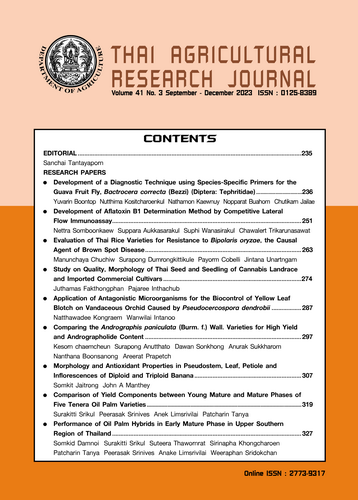Study on Quality, Morphology of Thai Seed and Seedling of Cannabis Landrace and Imported Commercial Cultivars
DOI:
https://doi.org/10.14456/thaidoa-agres.2023.23Keywords:
cannabis, seed, morphology, landrace, commerce varietyAbstract
Cannabis may be come an economic crop. In the past, study on cannabis seed aspects were limited due to legal prohibition. The objective of this study was to investigate the quality and morphology of seeds and seedlings of 10 landrace/collected cannabis cultivars in Thailand and 5 imported commercial cannabis cultivars. The experiment was conducted at cannabis planting greenhouse of Biotechnology Research and Development Office and laboratory of Seed Research and Development Division and Plant Varieties Protection Office, Department of Agriculture, during March 2021 – January 2022. Results showed that the ground color and pattern color of landrace/collected cannabis cultivar seeds in Thailand were gray brown and black while those of the imported commercial cannabis cultivar seeds were gray and brown. The 100-seed weight of the landrace/collected cannabis cultivar seeds showed more variation than that of the imported commercial cannabis cultivar seeds,1.1–3.1 and 2.4–4.7 g, respectively. Moreover, the imported commercial cannabis cultivar seeds gave the germination up to 100 %, speed of germination was 1.4 – 2.1 plants/day and height of cannabis seeding at 7 DAP was 7.0 – 9.2 cm., which were more than those of the landrace/collected cannabis cultivar seeds in all aspects. However, the seedling growth had the same digitate leaf shape pattern in leaf no. 1 – 5. The number of lobes increased according to number of leaf, 3 – 5 lobes on leaf no. 2 and 7 – 9 lobes on leaf no. 5. The data obtained from this study can be used in seed management, planning of planting or selection/breeding of cannabis variety in Thailand in order to enhance the use of cannabis for medical purpose in the future.
References
จวงจันทร์ ดวงพัตรา. 2529. เทคโนโลยีของเมล็ดพันธุ์.กลุ่มหนังสือเกษตร, กรุงเทพฯ. 210 หน้า.
บุญมีศิริ.2559.การปรับปรุงสภาพ และยกระดับคุณภาพเมล็ดพันธุ์. ภาควิชาพืชศาสตร์และทรัพยากรการเกษตร คณะเกษตรศาสตร์ มหาวิทยาลัยขอนแก่น. 239 หน้า.
ประกาศกระทรวงเกษตรและสหกรณ์2564. เรื่องกำหนดมาตรฐาน คุณภาพ และวิธีเก็บรักษาเมล็ดพันธุ์ควบคุม (ฉบับที่ 3) พ.ศ. 2564 แหล่งข้อมูล: https://www.doa.go.th/ard/wp-content/uploads/2021/08/Q.6-Canabis-2564.pdf สืบค้น: 15 มิถุนายน 2564.
ประกาศกระทรวงสาธารณสุข2565. เรื่องระบุชื่อยาเสพติดให้โทษในประเภท 5 พ.ศ. 2565. แหล่งข้อมูล: https://mnfda.fda.moph.go.th/narcotic/?p=11472. สืบค้น: 15 มิถุนายน 2564.
ประภัสสร ทิพย์รัตน์. 2565. ศูนย์วิทยาศาสตร์การแพทย์ที่ 1 เชียงใหม่. “พืชกัญชา: ความรู้ทั่วไป และการตรวจสอบสารสำคัญ”. แหล่งข้อมูล: https://www.oncb.go.th/ncsmi/cannabis4/.pdf.สืบค้น: 15 มิถุนายน 2564.
วันชัย จันทร์ประเสริฐ. 2553. สรีรวิทยาเมล็ดพันธุ์.ภาควิชาพืชไร ่นา คณะเกษตร มหาวิทยาลัยเกษตรศาสตร์. 213 หน้า.
สุรศักดิ์อิ่มเอี่ยม ศรัณณัฏฐ์แสนเสนาะ ประเสริฐสุขเจริญและฉัตรชัย สวัสดิไชย. 2562. ยาน่ารู้: กัญชา.วารสารศูนย์การศึกษาแพทย์ศาสตร์คลินิก โรงพยาบาลพระปกเกล้า. 36(4) : 356 - 362.
Acquaah, G. 2015. Conventional Plant Breeding Principles and Techniques. pp. 115–158 In: Advances in Plant Breeding Strategies: Breeding, Biotechnology and Molecular Tools. Springer, Cham. https://doi.org/ 10.1007/978-3-319-22521-0_5.
Chandra,S.,H.,Lata, I.A.,KhanandM.A.,ElSohly.2017. Cannabis sativa L.:botany andhorticulture. pp.79-100. In: Cannabis sativa L..-botany and biotechnology. Springer, Cham.
ClarkeR.1999.BotanyoftheGenusCannabis.pp.1-18. In: Advance in Hemp Research. CRC Press.
Dunford, N. 2020. Hemp Seed Oil Properties. Extensionof Oklahoma State University. USA. Available at: https://extension.okstate.edu/ fact-sheets/hemp-seed-oil-properties.html Accessed: November 5, 2022.
Ellison, S.2021. Hemp(Cannabis sativaL.) research priorities: Opinions from United States hemp stakeholders. GCB Bioenergy. 13(4): 562-569.
Elias, S.G., Y.C., Wu and C. S. David. 2020. Seed Quality of Hemp. Journal of Agricultural Hemp Research. 2(1) Article 2. Available at: https://digitalcommons.murraystate.edu/ jahr/vol2/iss1/2 Accessed: January 5, 2023.
Falconer, D S. 1989. Introduction to quantitative genetics. New York, Longman. 361 p.
ISTA. 2020. International rules for seed testing. ISTA, Bassersdorf, Switzerland. 300 p.
Mašková, T. and T. Herben. 2018. Root: shoot ratio in developing seedlings: How seedlings change their allocation in response to seed mass and ambient nutrient supply.Ecol. Evol.8(14):7143-7150.
Mi, R., A.G., Taylor, L.B., Smart and N.S., Mattson. 2020. Developing production guidelines for baby leaf hemp (Cannabis sativa L.) as an edible salad green: Cultivar, sowing density and seed size. Agriculture. 10(12): 617.
Piluzza, G., G., Delogu, A., Cabras, S., Marceddu and S., Bullitta.2013. Differentiationbetween fiber and drug types of hemp (Cannabis sativa L.) from a collection of wild and domesticated accessions. Genet. Resour. Crop. Evol. 60(8): 2331-2342.
Ranalli, P. 1999. Agronomical and physiological advances in hemp crops. pp. 61-84. In: Advances in Hemp Research. CRC Press.
Taylor, A. G., M., Amirkhani and H. Hill,2021. Modern seed technology. Agriculture. 11(7): 630.
Tenikecier, H. S. and T. Genctan, 2020. Effect of endosperm and seed size on some yield andquality characteristicsof wheat (triticum aestivum l. em thell). Current Trends in Natural Sciences. 9(17): 132-141.
White, C.M. 2019. A review of human studies assessing cannabidiol’s (CBD) therapeutic actions and potential. J. Clin. Pharmacol. 59(7): 923-934.
Yoshimatsu, K.,T. Kitazawa, N. Kawano, O. Iida and N. Kawahara. 2010. Characteristics of Cannabis sativaL.: Seedmorphology, germination and growth characteristics, and distinction from Hibiscus cannabinus L. Yakugaku Zasshi. J. Pharm Sci. Jpn. 130(2): 237-24.
Downloads
Published
How to Cite
Issue
Section
License
Copyright (c) 2023 Thai Agricultural Research Journal

This work is licensed under a Creative Commons Attribution-NonCommercial-NoDerivatives 4.0 International License.
Thai Agricultural Research Journal



